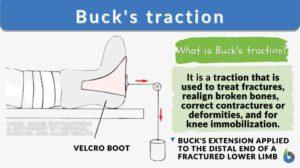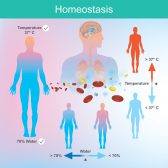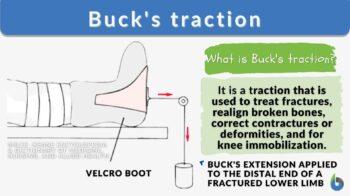
Bucks traction
n., [bʌk’s ˈtɹæk.ʃən]
Definition: Bucks traction is a traction for fractures of the femur (thigh bone)
Table of Contents
Buck’s Traction Definition
Buck’s traction for femur fracture is very helpful. It can be utilized in the treatment and realignment of broken bones, the correction of contractures or abnormalities, and the immobilization of the knee. Also called Buck’s extension, this traction is used in the short-term treatment of fractures of the following:
- Femoral neck
- Fractures of the femoral shaft in adolescents and adults
- Fractures of the femoral shaft in adolescents and adults
- Following the reduction of a hip dislocation
- To make small adjustments to flexed abnormalities of the hip or knee
- As a temporary measure for low back pain, pelvic rotation
The surgeon may choose to use tape or a pre-made Buck’s traction boot for this purpose. The weight should not exceed 4.5 kilograms at any point. In addition, it is not useful to acquire or maintain reduction.
Longitudinal traction is applied to an extremity in one direction using a single pulley while simultaneously maintaining an extended position for the leg and preventing hip flexion.
Buck’s Traction Purpose
The goals to maintain Buck’s traction position are as follows:
- Restore normal bone alignment and length, which is the primary purpose of the affected bone.
- Lessen or eliminate muscular spasms
- Reduce pressure on nerves
- Reducing the risk of developing skeletal abnormalities or muscular contractures, if possible.
- Put a fusiform tamponade around a bleeding vessel to stop the bleeding
Watch this vid about Buck’s traction:
Biology/Medical definition:
Buck’s traction is a type of physical therapy practice commonly used for the management of femoral fractures (thigh bone fractures). The goals to maintain Buck’s traction position are to restore normal bone alignment and length, lessen or eliminate muscular spasms and reduce pressure on nerves.
Synonyms: Buck’s extension
Universal Buck’s Traction
The inner liner is made of open-cell convoluted foam, and the exterior casing is made of foam laminate. The body is created in two pieces. When necessary for patient hygiene, the inner foam liner can be swapped out for a new one. The use of universal sizing helps to cut down on stocking inventory.
Adjustable for the patient’s convenience, the three elastic lower leg straps each have a contact clasp that secures them to one of the two sides of the outer casing. Foot drop can be prevented with the use of an adjustable elastic foot strap. It also has removable aluminum medial/lateral stays. The design includes a spreader bar that is 6 inches in width. It is ideal for fractures of the hip or femur (or both).

Traction Overview
Traction definition
Traction is a term used in the area of medicine to describe the process of slowly and gently pulling on a body part that has been fractured or dislocated. Ropes, pulleys, and weights are common tools used in the process.
Types of traction
- Manual Traction – meaning that the pull is applied physically using the hands
- Skin Traction – distributing the force over a vast region of the skin and other soft tissues to impart traction to the bone
- Skeletal Traction – This method involves applying force directly to the bone using metal pins that have been surgically implanted through the bone.
Techniques
Two additional techniques for applying traction to the skin and skeleton:
- Fixed: The pull is exerted between two locations that are not moving.
- Sliding: the pull is exerted by a pull between hanging weights and a pull between the patient’s body weight and the weight of the hanging weights.
Purpose of tractions
- Restore proper alignment and stability to a dislocated joint or shattered bone as soon as possible
- Assist in bringing the bone back to its normal position after it has been fractured
- By stretching the neck, you can relieve some of the strain that is being placed on the spine and realign the vertebrae
- Temporarily reduce pain before surgery
- Correct skeletal irregularities.
Define Skin Traction:
Skin traction is an effective treatment when treating problems that require only a moderate amount of pulling force. There are two primary categories of skin traction — adhesive and non-adhesive.
When treating femoral fractures, skin traction is frequently used as an emergency treatment before the patient has permanent surgical treatment. Some people only need traction for a short period, such as 24 hours, while others need it for several weeks.
The use of traction helps to relieve discomfort, spasms, and inflammation by limiting mobility, bringing the fracture closer together, and treating broken bones. After a bone has been fractured, this treatment intends to realign the broken bone so that it remains straight and maintains its length. The following figure shows how to apply skin traction.
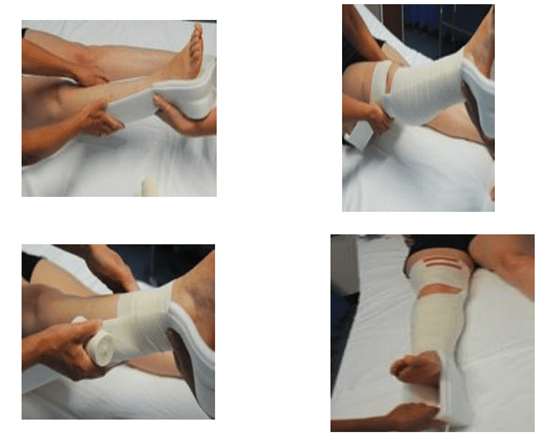
Other traction examples
Different types of traction procedures are used. Apart from Buck’s (skin) traction, other examples are as follows:
- Bryant Traction: One type of orthopedic traction is known as Bryant’s traction. The majority of patients who receive this treatment are infants and young children who suffer hip fracture pathophysiology or congenital deformities of the hip. Both of the patient’s legs are bent slightly at the knees and hips as they are held in a vertical position in the air at an angle of ninety degrees. A pulley system is used to slowly and progressively move the hips further away from the body over several days. The patient’s own body acts as the counter-traction in this situation.
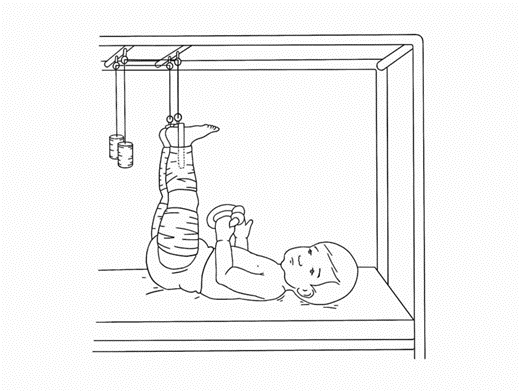
- Russell Traction: The term “Russell traction” is also used as traction for fracture. Pulling forces are applied in an upward and longitudinal direction using pulleys and weights, and the lower leg is held in place in a sling that is placed just below the knee. Russell traction either be skin traction or skeletal traction.
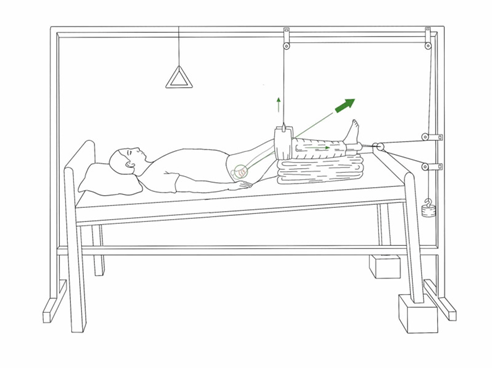
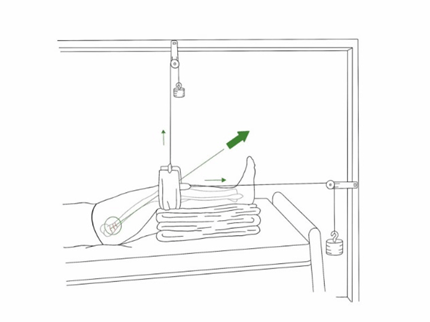
Management
Common forms of management:
- Acute Management
- Ongoing management
Acute Management
Check that the orthopedic nursing team has properly documented the order for skin traction (including Buck’s traction weight to be applied in kgs)
- Preparation of the necessary equipment (Buck’s traction splint)
- Traction kit available in pediatric or adult size (foam stirrup with rope and bandage)
- Hospital Traction bed with a bar at the end of the bed
- Overhead traction frame
- Pulley
- Sleek
- Water

Figure 6: From left to right: Traction Kit, Foam stirrup with rope, and Traction weight bag. Image Credit: The Royal Children’s Hospital Melbourne. Pain relief:
1. It is recommended that patients undergo a femoral nerve block in the emergency room before being admitted to the hospital. This method of pain management is more effective than other options.
2. The femoral nerve block should always be accompanied by the administration of oxycodone and diazepam, and both of these medications should be documented.Distraction and education:
1. Before beginning, make sure that both the patient and their parents understand the procedure.
2. Create a suitable diversion away from play therapy, parents, or other members of the nursing staff.Application of traction:
1. Check to see that the traction weight bag has been refilled with the prescribed quantity of water under the instructions provided by the attending physician.
2. As a form of weighted traction, it is usually recommended to make use of around 10 percent of the patient’s total body weight. When it comes to medical practice, a good rule of thumb is to start low and go slow. Additionally, weight needs to be introduced gradually but steadily. In most hospitals, you’ll find attaching weights that are either 2.5, 5, or 10 pounds.
3. Wrap the foam stirrup around the injured limb, ensuring that it covers the heel, ankle, and lower leg. Apply the bandage in a figure 8 pattern, beginning at the ankle and working your way up the lower leg; then, bind it with smooth tape.
4. Hang the traction weight bag from the rope that is placed over the pulley. If necessary, trim the rope to ensure that the traction weigh bag is hanging in the air rather than sitting on the ground.
Figure 7: Foam stirrup and bandage. Image Credit: The Royal Children’s Hospital Melbourne. Ongoing management
Maintain skin integrity:
1. The patient can develop pressure regions in their legs, heels, elbows, and buttocks as a result of remaining in the same position and wearing bandages.
2. To alleviate any potential pressure, roll up a towel or pillow and place it under the heel of the foot.
3. It is important to remind patients to reposition themselves or do pressure area treatment every four hours.
4. Once every shift, take off the foam stirrup and bandage to alleviate any potential pressure and observe the status of the patient’s skin.
5. Make sure the sheets are kept dry.
6. Maintain a record in the care plan and progress notes of the patient’s skin condition during treatment.
7. The pressure injury prevention score, as well as the plan, must be evaluated and documented.Traction care:
The following traction tools are required…
1. You need to make sure that the traction weight bag is not resting on the bed or the floor in any way. The bag must be swinging freely.
2. If the rope starts to fray, you should replace it.
3. The rope needs to be positioned within the pulley’s grooves.
4. Check to see that the bandages are smooth and without wrinkles.
5. Tilt the bed so that Buck’s traction counteraction is maintained.Observations:
1. Observe the patient’s neurovascular status every hour and document your findings in the patient’s medical record.
2. If the bandage is wrapped too tightly around the affected area, it may slow down the flow of blood.
3. To properly monitor for compartment syndrome, the patient’s femur should also be monitored for edema.
4. Remove the bandage and reapply it in a less restrictive manner if it is found that neurovascular impairment has occurred. If circulation does not improve, then it is mandatory to ask for professional advice.Pain Assessment and Management:
1. It is vital to do a pain assessment to guarantee that the appropriate analgesic will be supplied to achieve the targeted effect.
2. It is imperative that a chart is created for paracetamol, diazepam, and oxycodone, and that each medication is administered as required.
3. Before providing care to the patient’s pressure areas, it is important to first consider administering pre-emptive analgesia so that the patient’s pain is adequately managed.
4. Evaluate and keep a record of the outcomes of the various pain management strategies used.Activity:
1. The patient can remain seated in bed while engaging in calm activities such as watching television, playing board games, or working on crafts. Patients who are undergoing traction will benefit in the long term from play therapy.
2. Distraction and activities that do not involve the use of drugs will help in maintaining the patient comfort.
3. The patient is allowed to move around in bed as tolerated to complete their hygiene routine.
4. Patients who are going to be in traction for a significant amount of time might need to be sent to the education Buck’s traction nursing care department.Theatre time:
Traction should be used when transporting the patient to the operating room to minimize pain and ensure proper alignment.Maintenance of the Traction Apparatus:
1. The traction apparatus must be maintained at all times to ensure that the pull alignment is accurate.
2. The nurse is responsible for informing the attending physician if the traction is not properly aligned or if there appears to be a disparity in the number of pounds. A brief note is going to be documented by the nurse.
3. Every twelve (12) hours, the nurse is responsible for documenting the total number of pounds of traction.
4. The nurse is responsible for checking the traction device to ensure that the ropes are not hindered in any way, as they are not in contact with either the apparatus or the bed. They glide easily over the pulleys, and the weights can hang freely.Assessment of the Patient in Traction:
1. The nurse is responsible for carrying out the neurovascular, sensory, and motor examinations, as well as documenting the results.
2. What are his requirements exactly? Where does he fall short and why? It is the responsibility of the nurses to identify which tasks the patient is capable of performing alone and which tasks he needs assistance with. The most fundamental factors to take into account are dietary requirements, hygiene and elimination requirements, and the requirement for some form of distraction activities.
3. Any sudden changes in the patient’s feeling, mobility, or neurovascular condition have to be reported by the nurse to the attending physician as soon as possible.
Potential Complications
Following are the complications of buck’s traction:
- Breakdown of the skin in pressure places
- Neurovascular dysfunction
- Compartment syndrome
- Joint contractures
- Constipation from immobility and analgesics
- Sore heels
- Peroneal nerve damage
- Infections of the urinary tract
- Pin tract infection
- Loss of muscle mass
- Immobilization for extended periods in bed, resulting in the development of bed sores
- Excessive intake of available resources (nursing care)
The following are some of the drawbacks associated with extended skin traction:
- Weakening
- Involuntary contractions
- Adhesion
- Allergy
Frequently Asked Questions:
What is Buck’s traction for hip fracture?
Buck’s external traction is a technique that is frequently utilized in the treatment of femoral fractures, lower back pain, acetabular fractures, and hip fractures in the lower limb. Skin traction helps relieve discomfort and maintain length in fractures, but it only occasionally heals the fracture.
Why is Buck’s traction needed?
The primary advantages of skeletal traction are as follows:
1. Immobilization of a joint or of a bone.
2. Dislocations and fractures should be reduced or realigned.
3. Traction reduces and prevents the occurrence of muscular spasms.
Is traction a treatment that works effectively?
In the past, traction was regarded to be an art of treatment. However, in recent years, alternative surgical techniques have become more refined and effective in treating fractures, injured muscles, and spinal disorders. These improvements have been made possible by recent advances in the field. Because traction prevents patients from moving around much after surgery, recovery time is typically substantially longer when it is used. Its primary function in modern medicine is to serve as palliative care until permanent surgery can be carried out. During World War II, traction made it possible for soldiers to be carried without risk of harm to their surrounding tissues, which resulted in the saving of countless lives.
Traction, on the other hand, can be an effective treatment for a variety of illnesses. In the initial phases of treatment following an injury, it is an extremely efficient method for delivering immediate pain relief.
Answer the quiz below to check what you have learned so far about Buck’s traction.
References
- Crib, N. (2022). “Nursing Management of Patients in Traction.” Retrieved 29 July, 2022, from https://nursingcrib.com/demo-checklist/nursing-management-of-patients-in-traction/.
- “Universal Buck’s Traction.” (2022). Retrieved 29 July, 2022, from https://www.djoglobal.com/products/procare/universal-Buck’s-traction.
- “Russell traction.” (2022). Retrieved 29 July, 2022, from https://www.encyclopedia.com/caregiving/dictionaries-thesauruses-pictures-and-press-releases/russell-traction.
- “Purpose of Traction “. (2022). Retrieved 29 july, 2022, from https://www.verywellhealth.com/traction-fracture-and-broken-bone-treatment-2548529.
- “Traction an Effective Treatment?”. (2022). Retrieved 29 July, 2022, from https://www.healthline.com/health/traction#recovery.
- “Types of Traction.” (2022). Retrieved 29 July, 2022, from https://www.ncbi.nlm.nih.gov/pmc/articles/PMC7515792/.
- “Skin traction.” (2022). Retrieved 29 July, 2022, from https://www.rch.org.au/rchcpg/hospital_clinical_guideline_index/Skin_traction/.
- “SKIN TRACTION.” (2022). Retrieved 29 July, 2022, from https://www.worcsacute.nhs.uk/patient-information-and-leaflets/documents/patient-information-leaflets-a-z/2691-skin-traction/file.
- “General considerations.” (2022). Retrieved 29 July, 2022, from https://surgeryreference.aofoundation.org/orthopedic-trauma/adult-trauma/distal-femur/complete-articular-fracture-simple-articular-simple-methaphyseal/traction.
- “Application of traction in orthopaedics “. (2022). Retrieved 29 July, 2022, from https://www.slideshare.net/prabhnoorhayer/application-of-traction-in-orthopaedics.
- “Skin Traction – Lower Extremity.” (2022). Retrieved 29 July, 2022, from http://www0.sun.ac.za/ortho/webct-ortho/general/trac/trac-2.html.
- WebMD. (2022). “Skeletal Traction.” Retrieved 29 July, 2022, from https://www.webmd.com/pain-management/what-is-skeletal-traction.
- Choudhry, B., Leung, B., Filips, E., & Dhaliwal, K. (2020). Keeping the Traction on in Orthopaedics. Cureus. https://doi.org/10.7759/cureus.10034
©BiologyOnline.com. Content provided and moderated by Biology Online Editors.



